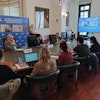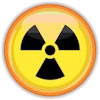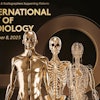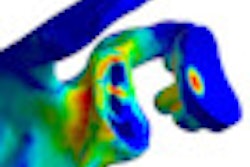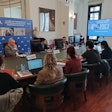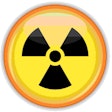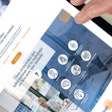
Dutch researchers have used computerized modeling to reduce access time for CT scans, while carving out more time for urgent scans. Their study shows how more patients can be scheduled and examined by managing access to imaging equipment -- without additional capital outlays or staff.
By inputting different scenarios for the use of their single CT scanner into the model, the team was able to trim average access times by nearly half to fewer than 10 days, as well as reduce the "diagnostic track" -- the time from the initial ordering of a CT scan to discussion of the results -- by about six days, on average.
"With a pre- and a postimplementation measurement, this study showed how computer simulation supported radiology management in their decision-making process on capacity allocation for different groups on the CT scanner," wrote Wineke van Lent and colleagues from the Netherlands Cancer Institute - Antoni van Leeuwenhoek Hospital (NKI-AVL) and the University of Twente (European Journal of Radiology, April 12, 2012).
The volume of high-cost diagnostic imaging such as CT and MR has increased substantially in recent years due to growing demand for scans. At the same time, however, hospitals lack the resources to extend their capacity, noted the authors.
"Without measurements to treat more patients while resources stay constant, this results in prolonged access times," they wrote. "Increasing the productivity is a preferable option to maintain costs, but this may be conflicting with achieving acceptable access times."
Short of the expensive solution of expanding capacity, improving operating procedures -- for example, by reducing changeover times -- and improving capacity allocation along with scheduling procedures can help reduce CT access times. But the solutions must be individualized to the patient group.
This is not an easy task, as CT demand is difficult to predict, but a solution may lie in operations research (OR), which uses mathematical techniques to quantify different suggestions for improvement by simulation, queuing, and linear programming, among other techniques. From the perspective of the patient and referring physician, overall throughput time for the diagnostic track -- the entire CT experience beginning with ordering the scan -- is more important than scanner access time alone, the authors wrote.
The study began with a preimplementation analysis at NKI-AVL, which used a single diagnostic CT scanner. Three scenarios were evaluated by computer simulation. After implementation, the same aspects were evaluated again, and effects on throughput time were measured for outpatient short-term and urgent requests.
The hospital assigns its available capacity in 10-minute time slots; these are filled with CT requests, which are called examinations after the scan is performed, van Lent and colleagues explained. An exam usually takes only one slot but may be composed of multiple procedures requiring multiple slots. Each operating day consisted of 40 standard slots reserved for urgent, short-term, and long-term requests with a planning horizon between one day and one year. Each day, one or two slots are reserved for CT requests involving drainage or biopsy. Ten slots are reserved for emergency requests that could not be completed in the original 40 time slots.
Radiology managers complained that long-term requests (those scheduled more than 20 days ahead, 33% of patient volume) used most of the standard slots, blocking capacity for other requests, which increased access time for everything but long-term requests. The problem was especially acute for urgent requests needing a scan within five days (15% of volume) and short-term requests for scans within 20 operating days (43% of volume). The final 9% of volume was reserved for hospital inpatients, always treated as emergency patients.
"To reduce the throughput time of the urgent and short-term patients, we focused on improving the capacity allocated of each type of request to the given capacity of one CT in this research setting," the authors stated.
They studied the effects of different scenarios on throughput times using pre- and postimplementation designs. Goals included preventing overtime to avoid the expense and the negative effects on staff, as well as preventing idle time during operating hours. Using a Monte Carlo simulation model, the authors modeled the effects of proposed scenarios to change throughput capacity. Simulation, commonly used in healthcare settings, was selected as the preferred OR technique.
Throughput time included the sum of access time to the CT, throughput time of the radiology report, access time between completion of the radiologist report and the second consult with the referring physician. The group measured throughput time for short-term and urgent requests. This process was informed by collecting all performed diagnostic CT requests for outpatients, total slots used to examine them, and the utilization rate -- calculated as the total number of slots used for exams divided by the capacity minus closures.
The analysis was based on six months of diagnostic exams during 2007 and 2008, and it included all RIS information on 3,261 performed exams, date of request, date of exam, report completion, referring specialty, planned number of slots, and urgency of the exam. After excluding outliers and exams with incomplete information, 812 (40%) of the exams were analyzed and throughput was calculated.
The authors designed the Monte Carlo simulation model using a Microsoft Excel spreadsheet, calculating CT utilization, overtime, and idle time based on parameters including access time for a specific request, the given number of slots, and slots per request type. The model was designed to allow the user to combine or separate capacity for urgent and short-term requests, van Lent and colleagues explained. CT to the second outpatient consult was not included in the model but targeted for three days due to the needs of referring physicians who were in the clinic twice a week.
To run the model, a set of parameters that make up the scenario needed to be inserted into it. The parameters included patient demand, CT access time targets, and available capacity.
The model categorized demand into four groups: inpatients, urgent outpatients, short-term outpatients, and long-term patients. The first three groups had most of the access problems as their appointments had to be scheduled within a month, and one year's historic data were used to establish the distributions. Using the Crystal Ball Decision Optimizer (Oracle) application, random patient demand data were generated for each group and inserted into the model. Exams and no shows accounted for 13 slots per day. Fifteen slots were allocated to long-term patients, and the user defined maximum access times for emergency, urgent, and short-term requests in a defined maximum of 55 slots per day.
Each morning the algorithm draws daily demand per group in slots, schedules each request in the available slot, and calculates if time is needed for the patient to consume oral contrast media for the exam. If no slots are available, the exam is performed in overtime. For each combination of desired CT access time and slots per request group, the model calculates the anticipated mean, standard deviation, and confidence interval for idle time, overtime, and hours needed for CT scanning, the group explained.
Management was asked to validate the model and check that the assumptions were plausible, then it was validated using historical data. Finally, scenarios were created to test the outcomes of projected inputs:
- Scenario 1 allocates slots to all groups and imposes a maximum throughput time of five operating days for urgent patients and 10 operating days for short-term requests.
- Scenario 2 combines the urgent and short-term slots with an access time of five operating days, the most patient-friendly outcome.
- Scenario 3 has a throughput time of less than seven operating days for the urgent and short-term patients.
The theoretical best scenario was defined as the one with the shortest diagnostic track throughput time with an acceptable amount of idle time and CT overtime. These were weighed and compared against practical considerations such the ability to handle unexpected equipment breakdowns and the potential of increased demand due to reduced access times. Finally, the team evaluated its results.
The preimplementation analysis showed an average CT access time of 9.8 operating days and a diagnostic track of 14.5 operating days. The simulation allowed a change in the capacity for different patient groups to enable a diagnostic track of 10 operating days with a CT access time of seven days. After implementing the changes, the average diagnostic track was 12.6 days with an average access time of 7.3 days. The percentage of patients with a total throughput time of 10 days or less increased from 29% to 44%, while utilization remained unchanged at 82%. In addition, idle time increased by 11% and overtime decreased by 82%, the group reported.
"This study showed how computer simulation supported radiology management in their decision-making process on capacity allocation for different groups on the CT scanner," van Lent and colleagues wrote, noting that very few previous papers have addressed model-based optimization in radiology, and only one tested the outcomes against projected results.
"Our study showed that the best scenario according to the model (the capacity allocation of scenario 2) was not selected because of practical considerations that were not included in the model, instead a variant to scenario 3 was implemented," they wrote. "Thus, the acceptability of the recommendations in practice is affected by sociodynamic factors."
Although the evaluation shows a reduced diagnostic throughput time 14.5 to 12.6 days, "in the new situation, 44% of diagnostic tracks were finished within 10 operating days versus 29% in the original situation," they wrote. "Hence, although the total throughput time has reduced, the desired levels have not been met for the majority of the eligible requests."
Performing fewer exams outside of the allotted slots has led to benefits including reduction in throughput time without affecting CT utilization. Another realization was that pooling slots -- for example, combining slots for urgent and short-term requests -- could lead to benefits. Farther along, better forecasting of expected demand in each patient group would help reduce wait times as capacity is better adjusted to demand, they wrote.
Among the limitations, there was difficulty matching many of the cases to the referring physician, the team reported. In addition, demand was assumed to be the same each day of the week, which is unlikely to be the case. A queuing model could have been used instead of a computer simulation with similar effects, the authors added.
This study was the first to include the entire diagnostic track and present the model and results both before and after implementation, the authors concluded. By increasing the number of available slots, the model can be adapted to sites with a larger CT capacity or longer operating hours.
"We conclude that using a model to determine the capacity required per patient type supports the decision-making process of radiology management on reducing throughput times while making efficient use of their capacity: In this case 52% more patients completed the diagnostic track within 10 days," van Lent and colleagues wrote.
